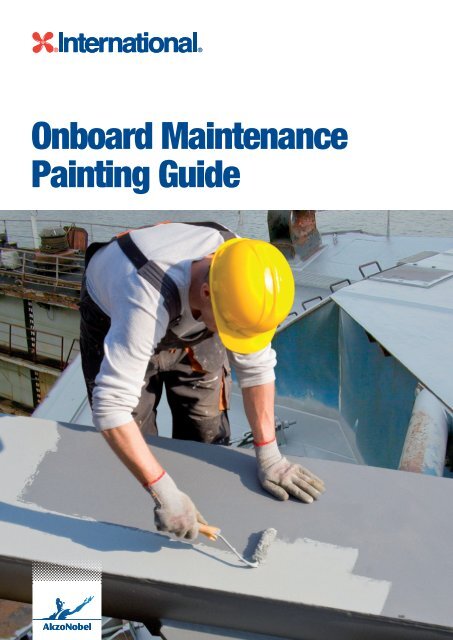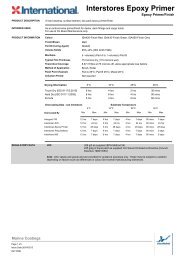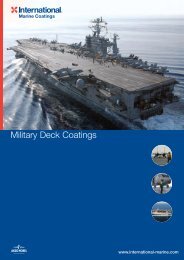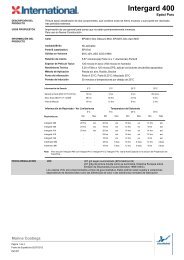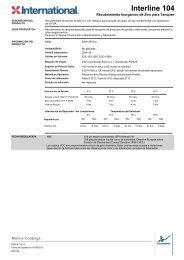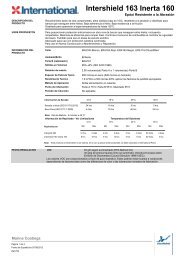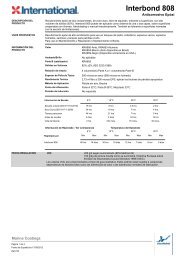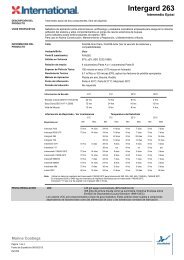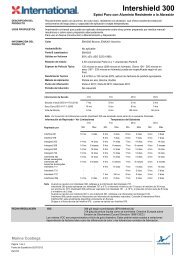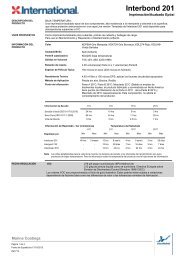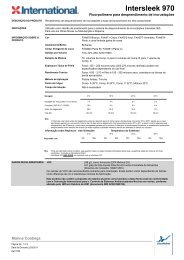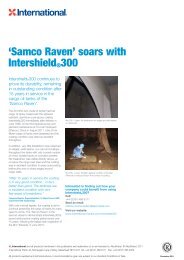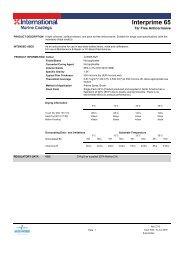Onboard Maintenance Painting Guide - International Marine Coatings
Onboard Maintenance Painting Guide - International Marine Coatings
Onboard Maintenance Painting Guide - International Marine Coatings
You also want an ePaper? Increase the reach of your titles
YUMPU automatically turns print PDFs into web optimized ePapers that Google loves.
<strong>Onboard</strong> <strong>Maintenance</strong><br />
<strong>Painting</strong> <strong>Guide</strong><br />
<strong>Marine</strong> <strong>Coatings</strong><br />
All products supplied and technical recommendations given are subject to our conditions of sale.<br />
OBM <strong>Painting</strong> <strong>Guide</strong><br />
1
Contents<br />
2<br />
Introduction and planning: 3<br />
Surface preparation: 4 - 5<br />
Paint application: 6 - 8<br />
Health and safety: 9 - 10<br />
<strong>Marine</strong> <strong>Coatings</strong><br />
All products supplied and technical recommendations given are subject to our conditions of sale.<br />
OBM <strong>Painting</strong> <strong>Guide</strong>
Introduction<br />
<strong>Onboard</strong> maintenance (OBM)<br />
of coating systems is important<br />
in maintaining the cosmetic<br />
appearance of your vessel,<br />
minimising the onset of corrosion<br />
and ensuring that your vessel<br />
stays in good condition which<br />
reduces the costs and time of<br />
scheduled dry dockings.<br />
This guide contains information on planning and<br />
carrying out OBM work efficiently and safely.<br />
Planning<br />
<strong>Maintenance</strong> painting onboard and alongside in port should<br />
be planned to maximise the efficient use of resources both<br />
in terms of crew time and in the volume of paint used.<br />
A well planned maintenance programme that involves<br />
evaluation of the entire process, good record-keeping, and<br />
use of high performance coating materials can mean less<br />
time and money spent on OBM in the long run.<br />
The success of any coating system relates directly to the<br />
level of care and attention paid to the fundamentals of good<br />
painting practice, particularly surface preparation, mixing<br />
of coating materials, and, of course, their application.<br />
Furthermore, the paint locker should be well ordered, the<br />
racks and shelves clearly labelled by product name, and<br />
good stock rotation should be followed. Outdated, worn,<br />
and poorly maintained equipment for preparation and<br />
application can dramatically reduce the success of OBM<br />
painting.<br />
Here is a simple checklist of good practices for improving<br />
onboard maintenance.<br />
• Perform an audit of equipment and invest in new<br />
equipment as needed.<br />
• Carry out an inventory of the paint, noting the age,<br />
coating type, and condition of the stock.<br />
• Ensure that a copy of the OBM paint specification is kept<br />
onboard in an easily accessible and well-known place.<br />
Once these steps have been taken, it is time to look at the<br />
critical vessel areas and the paint specification.<br />
The coating specification to be applied will be dependent<br />
upon the vessel area being treated and this will have an<br />
impact on planning the work. It is recommended that the<br />
vessel be sectioned off into small, manageable areas.<br />
An OBM planning meeting<br />
Key factors to consider are:<br />
• Time between coats in a multi coat specification<br />
• Time before access to painted areas is possible<br />
The technical data sheets for the products to be<br />
used provide the following information:<br />
• Touch dry time<br />
• Hard dry time<br />
• Minimum and maximum overcoating time<br />
• Working life (pot life) for two component products – (pot<br />
life, in practical terms, is the time from combining the<br />
components of a two component product to the point<br />
at which the mixed paint is no longer usable)<br />
• Equipment cleaners<br />
3<br />
Introduction and planning<br />
Surface preparation<br />
Paint application<br />
Health and safety
Introduction and planning<br />
Surface preparation<br />
Paint application<br />
Health and safety<br />
Surface preparation<br />
The single most important<br />
function which can influence<br />
paint performance is the quality<br />
of the surface preparation. The<br />
importance of removing oil,<br />
grease, old coatings, rust and<br />
other surface contaminants<br />
cannot be over stressed.<br />
The following process is recommended:<br />
• Freshwater wash – to remove all salt contamination.<br />
This is best achieved using something like a fan jet<br />
lance or a power washer if available<br />
• Degrease – to remove all surface grease and oil. This<br />
is usually done using rags or brushes soaked in solvent.<br />
If a painted surface is to be degreased without being<br />
damaged, a solvent must be chosen which will not<br />
dissolve the paint film.<br />
Freshwater washing<br />
4<br />
<strong>Marine</strong> <strong>Coatings</strong><br />
All products supplied and technical recommendations given are subject to our conditions of sale.<br />
OBM <strong>Painting</strong> <strong>Guide</strong><br />
• Steel preparation – For OBM, <strong>International</strong>®<br />
recommends that a standard of at least St2 thorough<br />
hand and power tool cleaning is achieved for bare steel<br />
areas. The existing coating should be taken back to a<br />
sound edge and the edges should be “feathered” back<br />
using a combination of manual methods:<br />
• Hard scraping or slicing – this is carried out with<br />
various types of scraper. Scrapers are useful for<br />
removing loose material.<br />
• Chipping hammers or chisels – chipping can<br />
be carried out using a wide variety of hammers<br />
or chisels, best results are obtained if chipping is<br />
followed by secondary preparation such as wire<br />
brushing.<br />
• Wire brushing can remove loose contamination,<br />
but it is ineffective at removing scale and deep<br />
seated corrosion.<br />
Hard scraping
Power tool methods of surface preparation<br />
Power tools used for cleaning fall into two basic categories<br />
– rotary cleaning tools and impact cleaning tools.<br />
• Rotary wire brushing using “braided” wire wheels<br />
Radial brushes are used for preparing awkward areas<br />
such as corners or weld seams. Cup brushes are more<br />
often used for preparing large areas.<br />
• Rotary discing cleaning of a surface is achieved by<br />
coated abrasive discs attached to angle grinders or by<br />
using abrasive flap wheels attached to straight or in-line<br />
tools.<br />
Rotary wire brushes<br />
For both rotary wire brushing and rotary discing, the<br />
surface must not be polished and it is essential that a<br />
surface profile is created.<br />
• Clean down – The prepared area should have any<br />
residual dust, paint flakes and debris removed by<br />
brushing or vacuuming. Paint application should<br />
begin as soon as possible after cleaning to prevent<br />
deterioration of the prepared surface.<br />
Rotary discing<br />
5<br />
Introduction and planning<br />
Surface preparation<br />
Paint application<br />
Health and safety
Introduction and planning<br />
Surface preparation<br />
Paint application<br />
Health and safety<br />
Paint application<br />
Paint mixing<br />
Before use, paints should be mixed well, following the<br />
instructions on the technical data sheet.<br />
• Thinning – thinning of paint is not recommended. Follow<br />
the guidelines on the technical data sheet.<br />
• Film thickness – it is important to apply the specified<br />
wet film thickness. This should be measured using a<br />
comb gauge.<br />
Wet film thickness should be measured with a comb gauge<br />
Brush selection<br />
Application by brush is recommended for patch priming<br />
and repair work to ensure good wetting of the substrate.<br />
This is essential when painting over manually prepared<br />
surfaces.<br />
• The choice of brush will depend upon the application<br />
required and the quality of finish to be achieved.<br />
• Flat square end brushes, often called wall brushes, are<br />
used on flat areas. Angular cut ‘sash’ brushes 2” - 3”<br />
(5cm - 8cm) wide are used on narrow surfaces, and<br />
round or elliptical section brushes are used on irregular<br />
shapes such as nuts and bolts.<br />
• Brushes with angled heads and long handles are used<br />
for painting the backs of stiffening bars and other<br />
inaccessible areas in tanks.<br />
6<br />
Brush application<br />
<strong>Marine</strong> <strong>Coatings</strong><br />
All products supplied and technical recommendations given are subject to our conditions of sale.<br />
OBM <strong>Painting</strong> <strong>Guide</strong><br />
• Brushes should not be dipped into the paint more than<br />
half the length of their bristles, the aim is to load the<br />
brush with enough paint to get some work done, but<br />
not too much so the paint drips and splatters.<br />
• The applied paint should spread evenly using smooth,<br />
steady strokes then be smoothed by light parallel<br />
strokes to eliminate irregularities.<br />
• On flat, vertical surfaces, it is best to finally lay off the<br />
paint in a vertical direction because this will reduce the<br />
tendency of the paint to run or sag.<br />
• Applicators should either be advised to apply a single<br />
“thick” coat or multiple thin coats which can be applied<br />
when the paint is touch dry if the area is accessible.<br />
• Particular attention should be paid in ensuring that the<br />
applied paint is brushed into the bottom of pitted areas<br />
of steel and that the edges of nuts, etc are well coated.<br />
Flat and round ended paint brushes<br />
The brush should be held like a pencil
Roller selection<br />
• Rollers are useful for applying paint to large flat areas<br />
such as tank tops, vertical sides, walkways and deck<br />
areas.<br />
• A short bristled brush is more practical for badly pitted<br />
and rough steel, because paint can be worked into the<br />
profile of the steel.<br />
• Roller application requires less skill from painters than<br />
brush application.<br />
• The most common roller fabrics used are lamb’s wool<br />
and mohair. Synthetic foam rollers have no role to play<br />
in the marine industry, they are prone to dissolve in the<br />
type of solvents used in heavy duty coatings and can<br />
swell and distort.<br />
• Roller covers vary in diameter, length, type of fabric and<br />
fibre length. Small diameter rollers are used for areas<br />
of awkward or difficult access, but the most common<br />
sizes are 1½” - 2” (4 - 5cm). Length can be anything<br />
from 1” to 18” (2.5 - 46cm), but the 9” length (23cm) is<br />
most popular.<br />
Roller application<br />
• Pitted areas should be touched up by brush before<br />
roller application.<br />
• Immerse the roller into the paint tray, roll it in the paint<br />
until fully saturated, and then roll it back and forth on the<br />
tray ramp to remove all excess material.<br />
• This not only avoids the problems of drips and splatters,<br />
but ensures that the roller is fully wetted and that air is<br />
removed from the fibre pile.<br />
Roller sleeves<br />
Roller application<br />
• Paint should then be applied to the surface by forming<br />
a ‘W’ or ‘M’ shape in the area to be coated. The ‘W’<br />
or ‘M’ shape area should then be filled by rolling back<br />
and forth until it is covered, with finished rolling in one<br />
direction so that appearance is uniform.<br />
• It is difficult to achieve high thickness in single<br />
coats; multiple applications can be required to meet<br />
specifications.<br />
• Over rolling can cause paint pick-up, particularly with<br />
fast drying coatings. This is often associated with<br />
serious entrapment of air.<br />
• An alternative to using paint trays is to put a roller grid<br />
in the paint bucket or paint tin and work out excess<br />
material on this. This can allow the painter to work from<br />
ladders or scaffolds.<br />
7<br />
Introduction and planning<br />
Surface preparation<br />
Paint application<br />
Health and safety
Introduction and planning<br />
Surface preparation<br />
Paint application<br />
Health and safety<br />
Comparison table<br />
The following table gives a simple comparison between<br />
brush and roller paint application:<br />
8<br />
Brush Good for small,<br />
complex areas<br />
Advantages Disadvantages<br />
Inexpensive<br />
equipment<br />
Minimal<br />
wastage<br />
Roller Faster than<br />
brushing<br />
Good for large<br />
flat areas<br />
They require<br />
more coats to<br />
achieve film<br />
thickness<br />
They require<br />
more coats to<br />
achieve correct<br />
film thickness<br />
Possibility of<br />
uneven film<br />
thickness<br />
Weather conditions<br />
<strong>Marine</strong> <strong>Coatings</strong><br />
All products supplied and technical recommendations given are subject to our conditions of sale.<br />
OBM <strong>Painting</strong> <strong>Guide</strong><br />
• Usually it is not possible to paint wet surfaces, if rain is<br />
forecast then exterior maintenance painting should be<br />
abandoned or suitable covering should be installed over<br />
the areas in question, condensation also needs to be<br />
avoided.<br />
• Condensation is formed when the steel temperature is<br />
lower than the atmospheric dew point; providing that<br />
the steel temperature is at least 3°C higher than the<br />
measured dew point then condensation is unlikely to<br />
occur and painting can proceed.<br />
• Extreme weather conditions can also cause problems<br />
during maintenance painting activities. Technical data<br />
sheets should be consulted during planning of any<br />
maintenance painting work:<br />
• Below 5°C the curing of two pack paints such as<br />
epoxies and polyurethanes can be slowed down.<br />
• Paints which dry by solvent evaporation such as alkyds<br />
and acrylics can be used below 0°C provided that the<br />
surface is free of frost and ice.<br />
• Above 30°C solvent can evaporate very quickly which<br />
can result in difficulties in brushing and rollering of paint.
Health and safety<br />
The primary source of health and<br />
safety information is the product<br />
Material Safety Data Sheet; these<br />
are available for all <strong>International</strong><br />
<strong>Marine</strong> products from:<br />
http://www.international-marine.com/products/msds.aspx<br />
<strong>International</strong>® also publishes a secondary source of health<br />
and safety information in the form of simple one page<br />
safety advice sheets, which are designed to help paint<br />
applicators, for example.<br />
advice sheet<br />
safety <strong>Marine</strong> & Protective <strong>Coatings</strong><br />
This contains basic health, safety and environmental information that is important for the<br />
actual user of the product. It does not replace the Material Safety Data Sheet.<br />
Product Name: Interlac 665 Ref No: 0015<br />
Use/Application<br />
Revision Number 1<br />
An alkyd cosmetic coating for use in non-immersed areas. May be applied by airless spray, conventional spray,<br />
brush or roller.<br />
Safety Dangers<br />
This paint contains solvents. When used or spilt it will release solvent vapours which may catch fire<br />
or explode.<br />
Health Dangers<br />
If breathed in, solvents may cause headaches and dizziness and long term nervous system<br />
damage. Paint in the eyes will cause irritation. Repeated splashes on the skin may cause irritation,<br />
loss of fat and skin damage (dermatitis).<br />
Control Measures<br />
Extraction/Local Extract Ventilation: When paint is used anywhere inside a confined space or<br />
area with limited ventilation on a ship or inside a building, forced extraction with fans must be used<br />
to stop solvent from creating an explosive mixture and to reduce the solvent concentration that<br />
people may breathe in.<br />
Ignition: Cigarettes, lighters, matches, welding or cutting torches, grinding and all electrical<br />
equipment except approved spark proof lights must be kept well away from paint mixing and paint<br />
application.<br />
Personal Protective Equipment<br />
Lungs (Inhalation) The sprayer and assistant should always wear a cartridge respirator. Other<br />
people who can smell paint should also wear a cartridge respirator or carbon mask unless they are<br />
or<br />
sure the solvent concentration is below the national occupational exposure limit (OES). Cartridge<br />
respirators and carbon masks become less efficient with time and should be replaced periodically.<br />
(Follow respirator manufacturers recommendations).<br />
Eyes: Wear safety glasses or goggles or a face shield at all times when mixing, spraying, rolling or<br />
or<br />
brushing paint.<br />
Skin: Wear an overall with full length sleeves and legs. Wear solvent resistant ‘rubber’ gloves (long<br />
sleeve). Wear safety boots. Make sure there is no gap at wrist and ankles. Change and wash the<br />
overall as appropriate and at least twice a week. If paint is able to pass through the overall, replace<br />
+ + + it. Wear a hard hat. Protect face skin with barrier cream (not petroleum jelly). Gloves should be<br />
replaced periodically.<br />
Hygiene/Cleanliness: Always wash hands before eating, smoking or going to the toilet. Paint<br />
transferred from the hands to other parts of the body can cause damage. Have a shower at the end<br />
of the working day.<br />
First Aid<br />
(In case of doubt seek<br />
Medical Advice)<br />
Breathing/Dizziness: If inhaled, quickly take the person to a place with fresh air. Lie them down<br />
and keep them warm. If breathing has stopped, give them artificial respiration (the ‘kiss of life’). If<br />
breathing is difficult give oxygen. Seek medical attention.<br />
Eyes: Give rapid assistance by holding the eyelids apart and washing with clean fresh water for at<br />
least 15 minutes. Afterwards seek medical attention (some paints stick to the eyes and need UV<br />
light to be seen and specialist cleaning to remove all traces of paint).<br />
Skin: Quickly remove clothing and wash skin with soap and water or a special skin cleaner. DO<br />
NOT use solvents (thinner/equipment cleaner).<br />
Mouth: If paint is accidentally swallowed quickly get a doctor or take the person to a hospital, DO<br />
NOT make the person vomit/be sick unless instructed to do so by medical personnel. If conscious<br />
they should drink as much water as possible. Never give anything by mouth to an unconscious<br />
person.<br />
Other<br />
Emergencies<br />
Spillage: Put sand/earth around spills to stop them getting into drains or rivers or the sea. Absorb<br />
the paint with more sand/earth and send to a special waste dump/treatment works.<br />
Fire: Fight fire with foam (large fires); Powder, CO2 foam (small fires).<br />
Waste Disposal Follow local regulatory requirements.<br />
Important Note<br />
The Product Data Sheet, the Material Safety Data Sheet and the package labelling together form an integral information system about this product. Copies of the Product<br />
Data Sheet and the Material Safety Data Sheet are available from <strong>International</strong> Paint on request or from our Internet sites: http//www.international-marine.com &<br />
http//www.international-pc.com<br />
Official Advisory Body Tel. No. For Advice to Doctors & Hospitals Only +44 (0)870 600 6266<br />
Country 24 Hr. Emergency Tel. No. Country 24 Hr. Emergency Tel. No.<br />
Australia +61 (0) 1 800 807 001 Sweden 112<br />
WM/Interlac 665/DS Finland +358 (0) 9 471 977 Turkey +90 (0) 216 574 31 91<br />
January 2004 Portugal +351 (0) 65 702 025 UK & Rest of World +44 (0) 191 469 6111<br />
Safety advice sheets for marine products are available from:<br />
http://www.international-marine.com/supportadvice/<br />
safety-advice-sheets.aspx<br />
The following notes give some very basic advice on health<br />
and safety when using <strong>International</strong> <strong>Marine</strong> paint:<br />
Health hazards<br />
• Over exposure can lead to irritation of the eyes and<br />
respiratory system. Excessive exposure can result in<br />
headache, nausea, dizziness and drowsiness and in<br />
extreme cases even loss of consciousness. Splashes<br />
in the eye will cause discomfort and possible damage.<br />
Prolonged contact with skin can lead to skin irritation<br />
and in some cases dermatitis.<br />
Health precautions<br />
• Inhalation – avoid breathing vapours; work in well<br />
ventilated areas and if necessary use local ventilation<br />
methods such as respirator masks.<br />
• Eye contact – avoid splashes in the eye by wearing<br />
suitable safety goggles or glasses.<br />
• Skin contact – avoid skin contact by wearing<br />
suitable clothing and gloves. Barrier creams are not an<br />
acceptable alternative to the proper choice of glove.<br />
• Ingestion - whilst there is little hazard by this route<br />
during onboard maintenance painting, do not eat<br />
whilst handling paint.<br />
First aid<br />
• Inhalation – remove the sufferer to fresh air,<br />
keep warm and rest.<br />
• Eye contact – wash with plenty of clean, fresh water<br />
for at least ten minutes holding the eyelids apart.<br />
• Skin contact – remove any contaminated clothing;<br />
wash the skin thoroughly with a proprietary skin<br />
cleanser. DO NOT USE SOLVENTS.<br />
• Ingestion – do not induce vomiting, seek medical advice.<br />
• General – in all cases of doubt seek medical attention.<br />
9<br />
Introduction and planning<br />
Surface preparation<br />
Paint application<br />
Health and safety
Introduction and planning<br />
Surface preparation<br />
Paint application<br />
Health and safety<br />
Fire and safety precautions<br />
• Storage – usually paint should be stored in dry,<br />
shaded conditions away from heat and ignition<br />
sources. Specific conditions can be found on individual<br />
product technical data sheets.<br />
• Ventilation – the use of suitable ventilation during<br />
painting operations should be promoted.<br />
• Ignition – painting should only be undertaken when<br />
all naked lights and unprotected electrical equipment<br />
have been removed from the area.<br />
• Waste disposal – any waste should be dealt with in<br />
accordance with prevalent local requirements.<br />
Personal protective equipment<br />
The following equipment should be used during onboard<br />
maintenance painting:<br />
• Overalls<br />
• Fluorescent or high visibility vest or jacket<br />
• Hearing protection<br />
• Dust mask<br />
10<br />
Safety helmet<br />
Gloves or gauntlets<br />
Overalls<br />
Safety boots and/or shoes<br />
Face mask and cartridge filters<br />
Hearing protection<br />
<strong>Marine</strong> <strong>Coatings</strong><br />
All products supplied and technical recommendations given are subject to our conditions of sale.<br />
OBM <strong>Painting</strong> <strong>Guide</strong><br />
Safety goggles Safety spectacles<br />
Dust mask<br />
Life jacket<br />
For further information:<br />
Fluorescent or high visibility<br />
vest or jacket<br />
The following should also be available as<br />
appropriate:<br />
• Life jacket, if working over water<br />
• A fall arrest safety harness and lanyard if working at height<br />
Fall arrest safety harness<br />
and lanyard<br />
Call: +44 (0)191 469 6111<br />
Fax: +44 (0)191 495 2003<br />
Send an email: marine.communication@akzonobel.com
<strong>International</strong> Paint Ltd is part of AkzoNobel,<br />
the Netherlands based company serving<br />
customers throughout the world with<br />
coatings and chemicals.<br />
<strong>International</strong> Paint Ltd,<br />
Stoneygate Lane, Felling<br />
Gateshead, NE10 0JY<br />
United Kingdom<br />
Call: +44 (0)191 469 6111<br />
Fax: +44 (0)191 495 2003<br />
Send an email:<br />
marine.communication@akzonobel.com<br />
Visit our website:<br />
www.international-marine.com<br />
Sign up to keep up to date with our latest news visit<br />
www.international-marine.com/signup<br />
Follow us<br />
Important Notes:<br />
All products supplied and technical advice or recommendations given are subject to our standard<br />
Conditions of Sale.<br />
The contents of this leaflet are for information purposes only and no representation or warranty of any<br />
kind is given in relation to any of the information or opinions expressed in it. Whilst we have made all<br />
reasonable efforts to ensure that statements appearing in this leaflet are accurate, we disclaim all liability and<br />
responsibility arising from any reliance placed on the information, advice and opinions contained in this leaflet.<br />
and <strong>International</strong>® and all products mentioned in this publication are trademarks of, or are licensed to,<br />
AkzoNobel. © AkzoNobel, 2012<br />
When you have finished<br />
with this brochure, pass it<br />
on to a colleague or recycle


